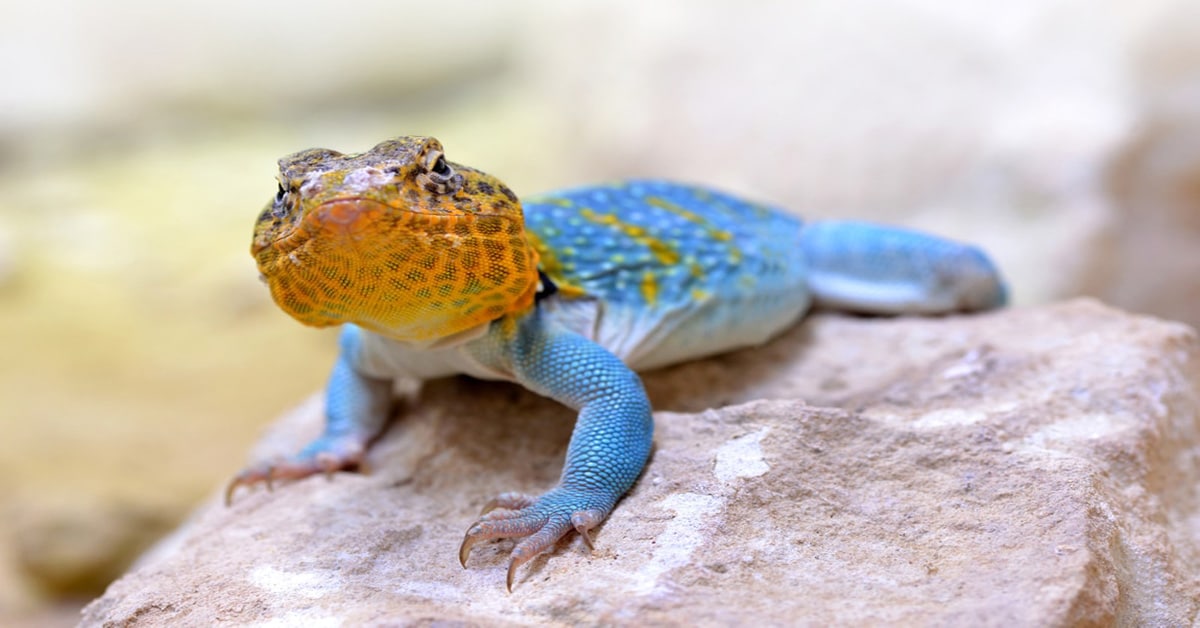Collared Lizard
Scientific Classification
| Kingdom: | Animalia |
| Phylum: | Chordata |
| Subphylum: | Vertebrata |
| Class: | Reptilia |
| Order: | Squamata |
| Suborder: | Iguania |
| Family: | Crotaphytidae |
| Genus: | Crotaphytus |
| Species: | C. collaris |
| Binomial name: | Crotaphytus collaris |
You can see the collared lizards, belonging to the family Crotaphytidae, order Squamata distributed all over the Western United States. You see them in the Sonoran Desert in southeast California, Arizona, and Northern Mexico which includes eastern Baja California.

Anatomy
The Collared Lizard Crotaphytus is of average size, about 10 inches in length from head to tail. The females are smaller than the males. This lizard has a large head. The lizard obtained this name because of the two black collars around its neck. The tiny scales on its body is colored olive, deep green, tan, blue tint or yellow with several dark colored cross bands and pale colored blotches. Its belly is more or less white. The young collared lizards have clear bands which gradually disappear as the reptile grows. The throat of the grown up males are deep green in color with bright spots. The color of the grown up females is dull green. During the breeding period, you can see orange or dark red bars and spots on the sides of the female’s neck and body, signifying pregnancy, once they lay the eggs, these become paler. Depending on the geographical location, the colors differ. The color of the male lizards varies from yellow, brown, blue and green, whereas that of the females range from beige, greenish-blue to gray.

Behavior
Collared lizards have a good looking appearance. They are alert and hunt stealthily, those in captivity are comparatively easy to tame.
Habitat
The habitat of the collared lizards is mainly rocky areas such as Sagebrush, desert grassland, pinyon-juniper and desert scrub. Normally you see them in open grasslands.
As a Pet
Breeding
Females lay 1 – 13 eggs in the beginning of summer; they reproduce several times in a year. The babies hatch during the beginning of the fall and the end of summer.
Housing

Since lizards are cold-blooded or ectothermic animals, this implies that they normalize the temperature of their bodies, according to the temperature of its surroundings. Hence, you would do well to create an atmosphere using various heat gradients such as cool area on one end and the warmer region on the other. Such an arrangement facilitates your pet to choose whether to go to the cooler area or warmer portion.
Use a terrarium that has solid glass sides and sufficiently long enough to have two different temperature gradients (cool and warm). To house an adult collared lizard a tank with a capacity of 30-40 gallons or bigger is will do, and for a juvenile 20L tank is OK.
Food
Most of the collared lizards are carnivores, although they consume a little vegetation food. Include in their diet gut-loaded and protein supplement dusted feed like kingworms, butter worms, pinky mice, crickets, mealworms, earthworms and cockroaches. When the lizards grow, feed them with tiny adult mice.
Be cautious that you feed your pet with the size of prey proportionate to its size. The thumb rule is that you should not feed your pet lizard with a cricket that is bigger than the gap between the lizard’s eyes, or the gap between its nostrils and its eyes. Prior to feeding your pet with big sized insects, ensure that they have molted just before feeding them, because the tough exoskeleton is hard to digest and likely to cause impactions.
All through the day make available a big bowl of fresh and clean chlorine-free water; keep it on the cooler side of the terrarium. It is likely that your pet will also take a bath in the enclosure. Hence, replace the water daily or when required.
Dark leafy vegetables such as mustard green and collard, red tipped leaf lettuce and kale are ideal for a lizard, just the way broccoli, clover, green beans, parsley, peas, grated carrot, squash and sweet potatoes are. Never feed your collared lizard with iceberg lettuce and spinach. The other food items that you can feed them infrequently are fruits such as raspberry, kiwi, strawberry, figs, and melons. Ensure that you wash the vegetables properly and for easy digestion, shred or cut them.
Handling
It is very easy to tame most of the collared lizards, and you can see them near the sides of the cage due to their inquisitiveness. Some wild caught lizards do not adjust with human beings, but this rarely occurs.

Having discovered a fondness for insects while pursuing her degree in Biology, Randi Jones was quite bugged to know that people usually dismissed these little creatures as “creepy-crawlies”.







